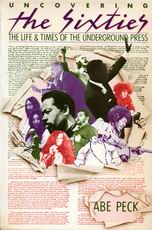
| Home News Releases | Calendar Contact |
Sources Bookshelf

Uncovering the Sixties
Life and Times of the Undergound Press
Peck, Abe
Publisher: Underground Press, New York, USAYear Published: 1985
Pages: 364pp
Dewey: 071.3
Abe Peck discusses the lives and passions of those involved in the underground media community in the 1960s. The Sixties could be considered a decade of differences. Not only were there the "mainstream" and the "non-mainstream" communities, but those of the non-"mainstream" were divided into many groups with separate beliefs. However, despite their differing politics, almost every "non-mainstream" or underground press institution emerged as a response to unhappiness with the social conditions and the media of the time.
These papers were "counter-institutions" which existed to "mirror, spark, express, organize, advocate, and hype the strands of protest." Unlike mainstream papers that projected and aura of objectivity but ignored their underlying political assumptions, the underground press offered an "honest subjectivity." The mainstream media caused people "to sympathize or rejoice, but not to organize politically." It was the more radical, provocative approach taken by the underground press that helped it become so influential.
As Peck recounts, the underground press scene of the Sixties may have started with a radical magazine called the Realist that presented free-thought criticism through satire. Its writers were clearly opinionated and unafraid to express their views. Other similar publications, such as the L.A. Free Press, the Seed, and East Village Other were created with the same ideals.
Peck's work describes the major news stories of the Sixties but his focus is on how they affected and directed the lives of those involved in the underground press. Underground papers gave writers a medium through which they could express themselves freely, even if they held ideas considered too radical for mainstream media. As a result, these publications ended up presenting a "counter-vision" for society that inspired a generation of rebels and reformers.
[Abstract by Oliver Mao]
Table of Contents
Preface
The Photo-Underground
The First Wave: 5/64-2/67
The Summer of Love: 3/67-2/68
The Summer of Detroit and Vietnam: 4/67-10/67
The Fall of the Pentagon: 10/67-4/68
King and Columbia: 4/68-6/68
Chicago: Hips, Yips, and Power Trips: 10/67-8/68
Revolution? 6/68-11/68
Paranoia Strikes Deep: 7/68-2/69
Street-Fighting Men? 11/68-5/69
From Counterculture to Over-the-Counter Culture: 10/68-8/69
Under Fire: 5/69-12/69
The Rat Women and the Stonewall: 7/69-6/70
Apocalypse Now: 12/69-7/70
Pressing On, Moving On: 6/70-5/71
The Howling: 5/71-12/72
America Drinks Up and Goes Home: 1/73-8/73
After the Revolution: Where are they Now?
Notes
Bibliography
Index
Subject Headings
- Activism/Radicalism
- African Americans
- Alternative Media
- Anti-Authoritarianism
- Anti-War Movement
- Black Panthers
- Black Power
- Bombing
- Chicago Democratic Convention 1968
- Civil Rights
- Counter-Culture
- Drugs
- Federal Bureau of Investigation (FBI)
- Gay & Lesbian Rights
- Hippies
- Left History
- Liberation Movements
- Lifestyles
- Mass Media
- Media
- Media Bias
- Media Co-operatives
- Media/Influence of
- New Left
- Newspapers
- Newspapers/Community
- Newspapers/Radical
- 1968
- Obscenity
- Political Action
- Political Alternatives
- Political Demonstrations
- Political Movements
- Politics/Rhetoric/Reality
- Resistance
- Revolution
- Revolutionary Politics
- Rock 'n Roll
- Sixties
- Students for a Democratic Society
- Underground Papers
- U.S. Central Intelligence Agency (CIA)
- U.S. History
- Vietnam War
- Violence
- Women's Liberation Movement
- Women's Movement
- Youth Activism
© Sources 2023. The information provided is copyright and may not be reproduced in any form or by any means (whether electronic, mechanical or photographic), or stored in an electronic retrieval system, without written permission of the publisher.